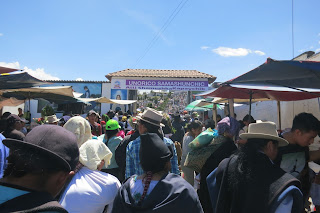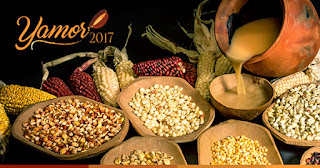💀 Day of the Dead 💀
Part of the reason Halloween isn’t a big celebration in
Ecuador is because November 1-2 are important holidays. You might be familiar
with the Day of the Dead if you took high school Spanish or watched Disney’s Coco (which is every bit as popular in
Ecuador as it is in the US), but I think the focus in the US tends to be on
Mexico’s celebrations and overshadows the celebrations in other Latin American
countries. Called Día de los Muertos in Mexico or Día
de los Difuntos in Ecuador ("Day of the
Dead" or All Souls’ Day) (Nov. 2), this holiday commemorates the
souls of all Catholics who have died and follows All Saints' Day (Nov. 1).
I was fortunate that an indigenous family I work with
invited me to accompany them to the cemetery (it’s less of a private experience
than in the US) so I could experience the holiday for myself. I was shocked to
see the cemetery packed. And I do mean packed. There were hundreds of people!! I actually waited at the entrance gate for nearly 30 minutes because I had no idea where to go in the cemetery and my friend couldn't hear her cellphone over the noise!
I know it is an important holiday, but I was wholly unprepared for the sheer
amount of people who would be in the cemetery and the surrounding streets! In
fact, the streets nearby were shut down to traffic due to the large number of
people entering and leaving the cemetery on foot.
It was almost impossible to walk through the cemetery because there were so many people. I kept worrying about my friend's 5 year old girl and carried her at times so she didn’t get run over by the crowd. Everyone had flowers and food. In addition to the food offerings for the dead (bread, eggs, fruit), families also bring food for the living (potatoes, beans, meat, and fish - I'm pretty sure there's a reason for the fish, but I don't know what it is. All I know is the street is full of stands selling this foul smelling fish I can't imagine eating, but it's a delicacy required for cemetery visits).
Many families brought handheld
umbrellas or umbrella stands like what they use in the market to provide shade,
since it was an incredibly sunny day and the families spend hours in the
cemetery, saying prayers, giving offerings, eating, and exchanging food with
other families and acquaintances. In fact, some of the same food passed between
three or more people before finally reaching its destination. In other words,
people kept re-gifting the same food items, in particular bread (including the
kind of bread I made with the same family and the special bread made this time
of year in the shape of babies, a dolls, and animals) and fruit.
I have never been in Ecuador during November, and therefore
have never experienced this holiday before. I was sick on Wednesday, so I was
disappointed to miss the parade. (Parades
are a big deal in Ecuador, not a few firetrucks and police cars and it’s over
in 10 minutes, like in Bradford. See my Yamor posts.) Since I had been told that many families
celebrate on November 1st and 2nd, I was hoping to experience the festivities
both days. However, no one I knew was actually celebrating yesterday (Nov. 1).
Although this holiday is also celebrated by mestizos, again, no one I know is
actually celebrating it. In fact, many indigenous families opted not to
celebrate the holiday on Nov. 2 but to wait until the following Monday (the
traditional day to visit cemeteries in all year long). I now understand why some
families opted to wait. I honestly don’t know how everyone could’ve fit if more
families had come to the cemetery! Something about having so many people
together in the cemetery all celebrating with their dead loved ones creates a
certain kind of energy, but it’s certainly not an intimate setting to remember
one's own loved ones who have passed away. Instead, there is sort of a shared sense
of connection to all living and all dead members of the community on this
holiday.
Here is the cemetery on Dia de los Difuntos -- so full of people, you almost can't make them out. And here is the cemetery the following week for reference. What a difference a day makes!!
Throughout this week (and the following week), different people have asked me about US traditions for burying and visiting our dead loved ones. The closest thing we have to the Dia de los difuntos holiday is Memorial Day, but it really doesn't feel comparable after having experienced the Ecuadorian version. For Americans, Memorial Day is often a somber occasion, or at least an obligatory one. People buy flowers and take care of the grave sites. They may even visit for a few minutes, but then they go back to their lives, often having often having picnics, parties, and parades. Even though the holiday is meant to remember the dead, so focus seems to be more on the living. In Ecuador, people spend half a day or an entire day in the cemetery. As with most death rituals, I'm sure this holiday is for the living, but somehow the focus seems more on the dead (or perhaps I simply have a skewed perspective as an outsider). I also have a strong feeling that Memorial Day becomes less and less about the dead in the US as families move farther and farther away. It's simply isn't practical to return to one’s hometown to spend the day with the dead or taking care of their final resting places. Instead, folks use the holiday as an excuse for a party, which is why I feel like the day is more about the living, and not even necessarily one's own family but about their friends and contacts. I feel like in Appalachia, extended families are slightly more intact than in the rest of the US, but it seems like even that is changing.
I know that as an anthropologist, I should be accustomed to new experiences and should be able to describe them. In all honesty, the experience of Dia de los difuntos was incredible but overwhelming, and I don’t think my writing does it justice. A few hours later in the same day (and even a few weeks later while editing my notes/writing this blog), I find myself still trying to process the experience and find adequate words to explain it.









Comments
Post a Comment